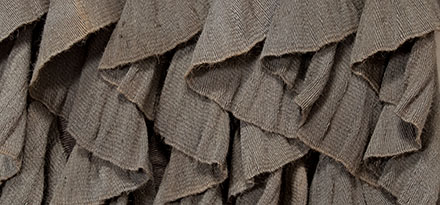
Details of works by Lenore Tawney, Sheila Hicks, Françoise Grossen and Mariette-Rousseau-Vermette, Photos by tom grotta
Fiber art experimentation by artist in North America including Lenore Tawney, Sheila Hicks, Françoise Grossen (a Swiss living in the US) and Mariette Rousseau-Vermette in Canada was a feature of the 1960s. The Museum of Modern Art recognized this directional shift in the seminal 1969 Wall Hangings exhibition, curated by Jack Lenor Larsen and then-MOMA curator, Mildred Constantine. The last 10 years “have caused us to revise our concepts of this craft and view the work within the context of 20th century art,” the curators explained. The exhibition featured 13
artists from North American including Tawney, Hicks, Grossen, Rousseau-Vermette, Ed Rossbach, Sherri Smith and Kay Sekimachi. “The American works tend to be more exploratory and less monumental,” the curators noted, “as illustrated by the ‘sketchy’ and transparent quality of the free-hanging, gossamer piece of nylon monofilament by Kay Sekimachi.” Sherri Smith used gradated color to reinforce the three-dimensional effect of the expanded waffle weave that forms Volcano No. 10. Several of these American artists were featured in the 4th International Tapestry Biennial in Lausanne that the same year, across the Atlantic. “What an event!” writes Erika Billeter in her historical essay, “The Lausanne Tapestry Biennials,” (16th Lausanne International Biennial: Criss-Crossings, 1995, pp. 36-53). Sheila Hicks shows a free-hanging work inspired by ancient Peruvian techniques and Françoise Grossen approaches macrame, thought to be “old hat”, says Billeter, “with such freedom, she transforms it into a hitherto unexplored contribution to this avant-garde textile art.” By 1969, Mariette Rousseau-Vermette was already a “favorite” of the Biennials, getting noticed for her “abstract and highly pictorial pieces with their highly worked surfaces.” Lenore Tawney did not have work in the 4th Biennial, but she had an influence nonetheless, through Susan
Weitzman’s Homage to Lenore Tawney, a transparent mural leaf, made solely of warp yarn. Lia Cook would join this influential group a few years later, finishing her masters degree and gaining international recognition at the 6th Biennial in 1973, with a 10-foot by 12-foot black-and-white optic weaving entitled, Space Continuum. Also gaining recognition in the
1970s, was Adela Akers whose work was included in the Inaugural Exhibition of the American Craft Museum in New York. Her work illustrates how timeless these artists’ explorations have been. “Contextualizing Adela Akers,” writes Ezra Shales, in the catalog for Influence and and Evolution, “one could say that she was born in Spain and trained in Cuba as a pharmacist before she went to Cranbrook, or that she taught at Tyler for decades, but one could not, relying on eye and hand alone, place [her] works as a fixed chronology with any absolute surety.” Works by Tawney, Hicks, Grossen, Rousseau-Vermette, Rossbach, Smith, Cook, Sekimachi and Akers from the 1960s through the 2000s will be among those featured in Influence and Evolution: Fiber Sculpture…then and now at browngrotta arts, Wilton, Connecticut from April 24th through May 3rd. The Artists Reception and Opening is on Saturday April 25th, 1pm to 6pm. The hours for Sunday April 26th through May 3rd are 10am to 5pm. To make an appointment earlier than 10am or later than 5pm, call: 203-834-0623.



